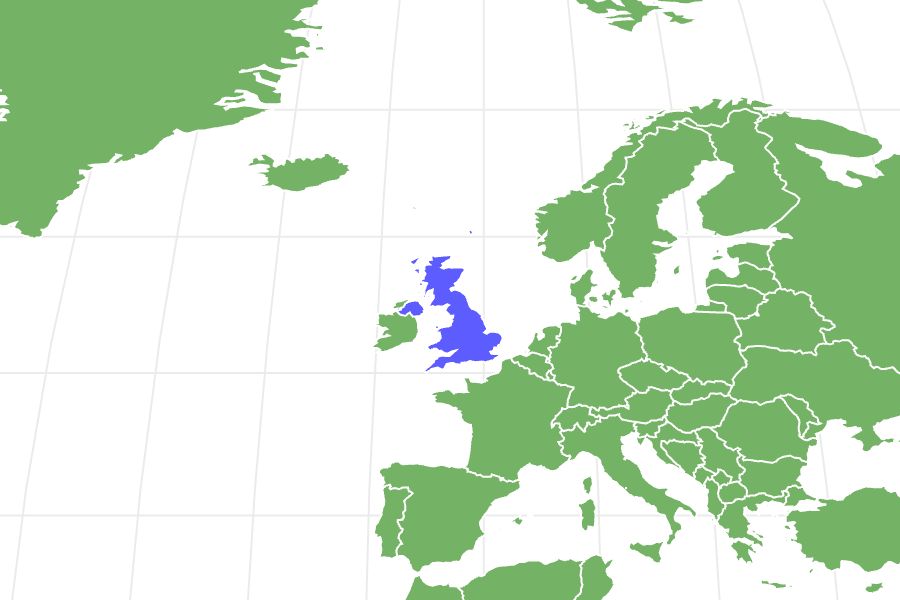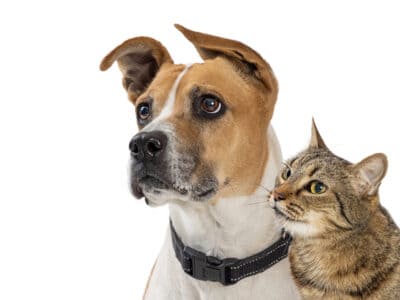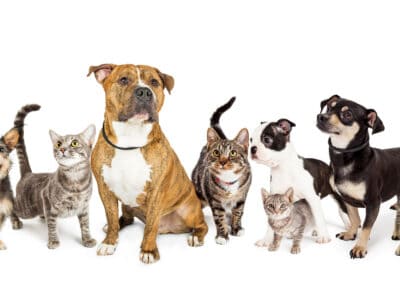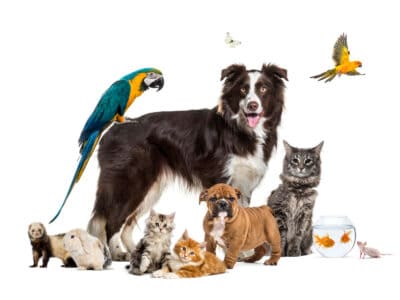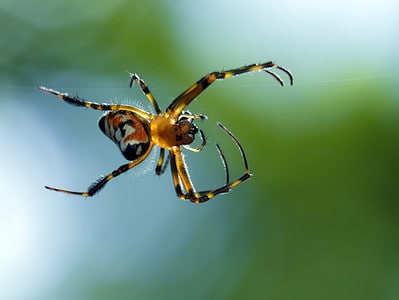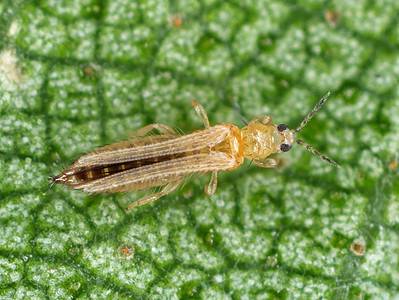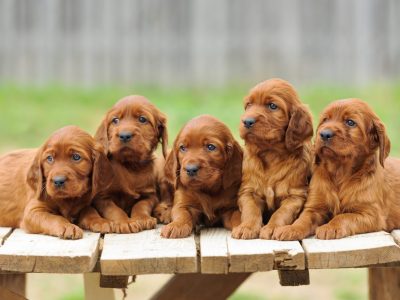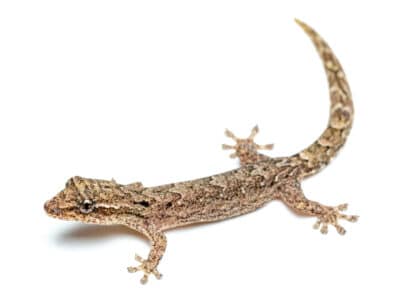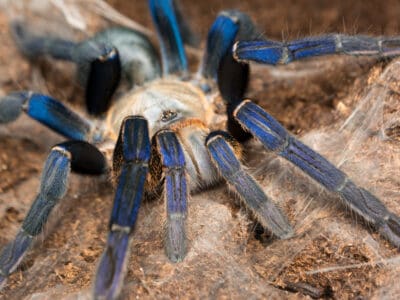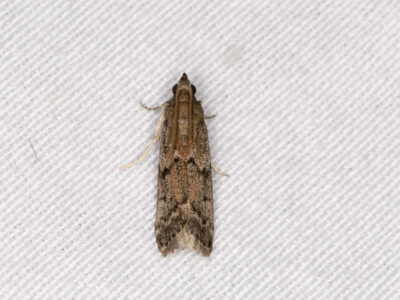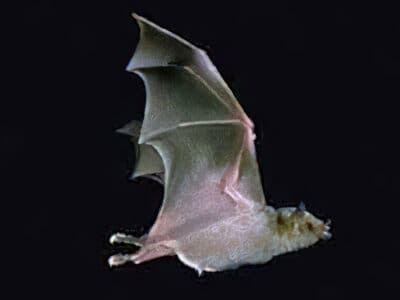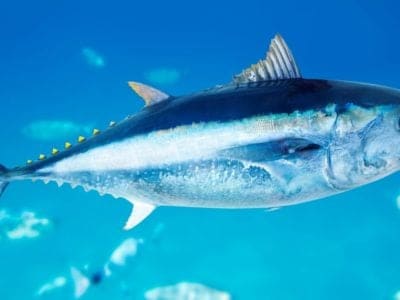Mastiff
Canis lupus
Courageous, calm and affectionate!
Advertisement
Mastiff Scientific Classification
- Kingdom
- Animalia
- Phylum
- Chordata
- Class
- Mammalia
- Order
- Carnivora
- Family
- Canidae
- Genus
- Canis
- Scientific Name
- Canis lupus
Read our Complete Guide to Classification of Animals.
Mastiff Conservation Status
Mastiff Facts
Mastiff as a Pet:
- General Health
- Energy Level
- Shedability
- Trainability
- Intelligence
- Tendency to Chew
- Size
- Family and kid friendliness
- Yappiness / Barking
- Moderate
- Separation Anxiety
- Moderate
- Preferred Temperature
- Average climate
- Exercise Needs
- Moderate
- Friendly With Other Dogs
- Moderate
- Pure bred cost to own
- $1800 to $2,500
- Dog group
- Working
- Male weight
- -230 lbs
- Female weight
- -170 lbs
This post may contain affiliate links to our partners like Chewy, Amazon, and others. Purchasing through these helps us further the A-Z Animals mission to educate about the world's species.
View all of the Mastiff images!
The mastiff is known for its large size, friendliness, loyalty, and affectionate nature.
There are several breeds of mastiffs including the Bull, English, Italian, Neapolitan, French, and Tibetan mastiffs. Though the color and appearance of the various breeds differ a little, they all share the same gentle temperament making this an ideal family dog.
See all of our expert product reviews.
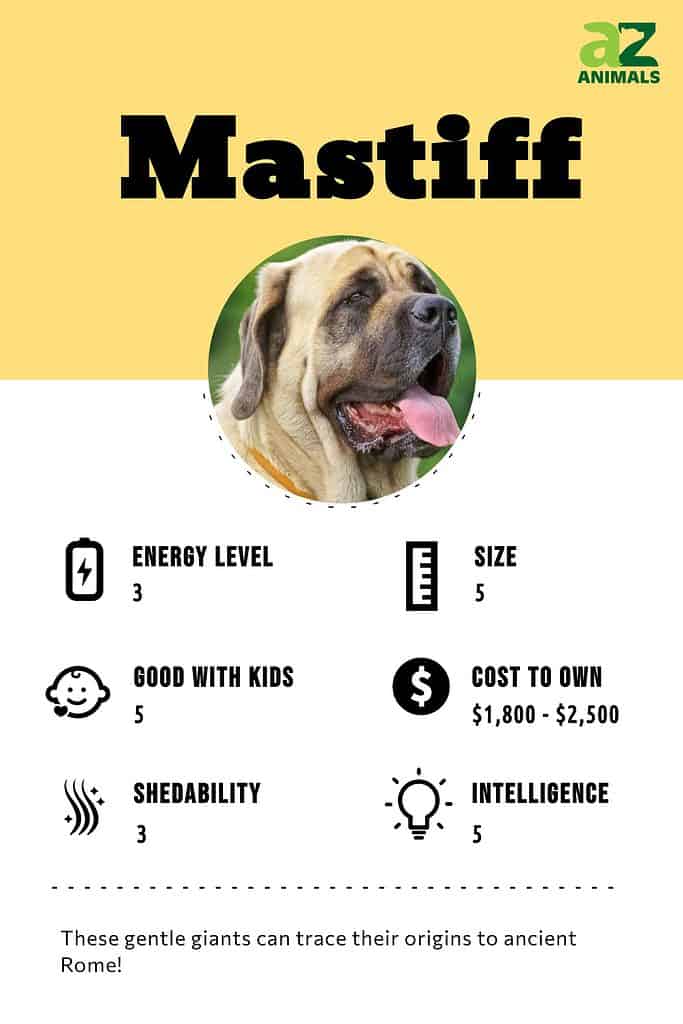
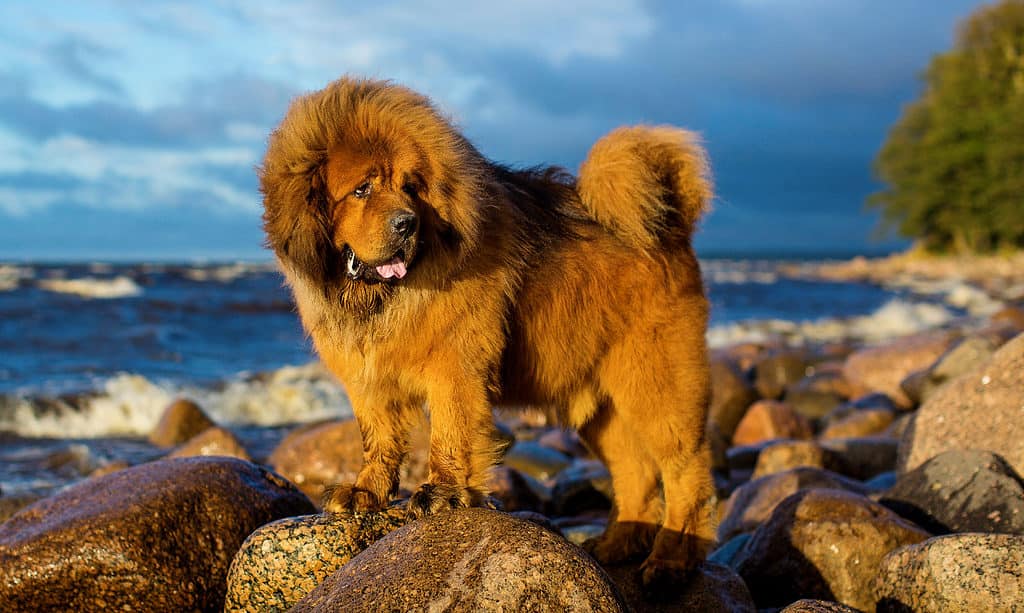
The Tibetan mastiff has a heavy coat with a “lions mane” around its magnifcent head.
©Kat_marinina/Shutterstock.com
The Tibetan mastiff stands out the most from its cousins. It has a heavy coat with hair around its head that looks similar to a lion’s mane. It needs a more extensive grooming routine than other mastiffs.
The mastiff breed dates all the way back to ancient Rome and Egypt. Back in 55 BC, they were owned by many people in noble families. They were used as guard dogs because of their courage and intimidating appearance.
Mastiffs are part of the working group of dogs. They are smart, sensitive, and gentle. A family looking for a large, sweet addition to their household may find a mastiff to be the perfect fit!
Health and Entertainment for your Mastiff
See all of our expert product reviews.
Evolution
While there are different types of Mastiff, they can all trace their origins to ancient civilizations in Egypt and Rome. It is said that Caesar described a mastiff in his accounts of invading Britain in 55 B.C.
Mastiffs were bred to be guard and fighting dogs and were frequently pitted against bears, bulls, lions, tigers and human gladiators in ancient Rome. Their bravery paired with brute strength and an imposing manner made them a favorite of the Romans. Breeders all over the world developed types to suit regional needs and preferences – but they all exhibit the same dignified strength, massive size and kind manner toward their families.
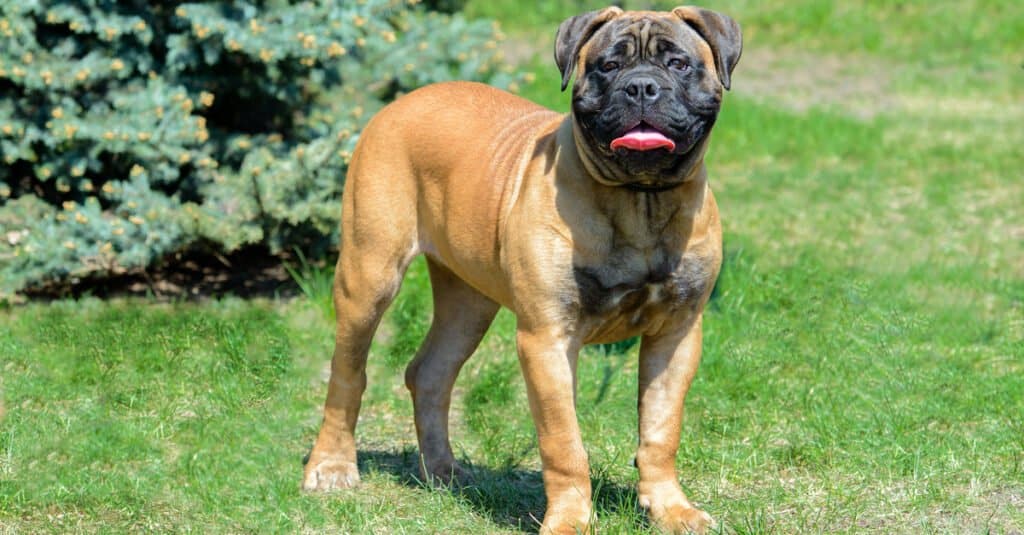
The Bull mastiff is a cross between an English mastiff and an Old English Bulldog.
©volofin/Shutterstock.com
Types of Mastiff
- Bull Mastiff: A cross between an English mastiff and an Old English Bulldog, the Bull mastiff was bred in the 19th century to be the ultimate guard dog. Not quite as big as other mastiffs, the Bull still gets up to 130 pounds. With intelligent, dark eyes and the classic mastiff broad head, this dog shares the kind disposition toward its family of the other mastiffs.
- English Mastiff: Also known as the Mastiff, this colossal canine is strong and courageous while also sweet and dignified. Even though they are so huge, their giant broad head with wrinkled brow and masked muzzle features a kind expression.
- Italian Mastiff: Also known as the Cane Corso, this massive mastiff can trace its orgins to ancient Rome, where it was known as the bodyguard dog. These dogs are very intimidating with a short stiff coat, huge head and rippling muscles. In Roman times these dogs were used as war dogs who fearlessly charged enemy lines with flaming oil-filled buckets attached to their backs.
- Neopolitan Mastiff: The massive Neopolitan mastiff has been guarding homes against intruders since the days of ancient Rome. This heavily wrinkled behemoth is sweet to its loved ones but wary of strangers. Its massive head is so wrinkled it looks as if it melted in the sun! Neopolitans come in black, mahogany, tawny and blue.
- French Mastiff: Also known as Bordeaux mastiff, the Bordeaux has a powerful, muscular body capable of pulling carts, transporting heavy objects and guarding flocks. They are fawn-colored with a massive bulldog-like head and undershot jaw.
- Tibetan Mastiff: These imposing giants are considered one of the best guard dogs with their watchful, imposing and intimidating presence. Sweet and mellow with their families, Tibetan mastiffs are territorial and somewhat aloof with strangers. These noble canines have v-shaped ears and expressive brown eyes.
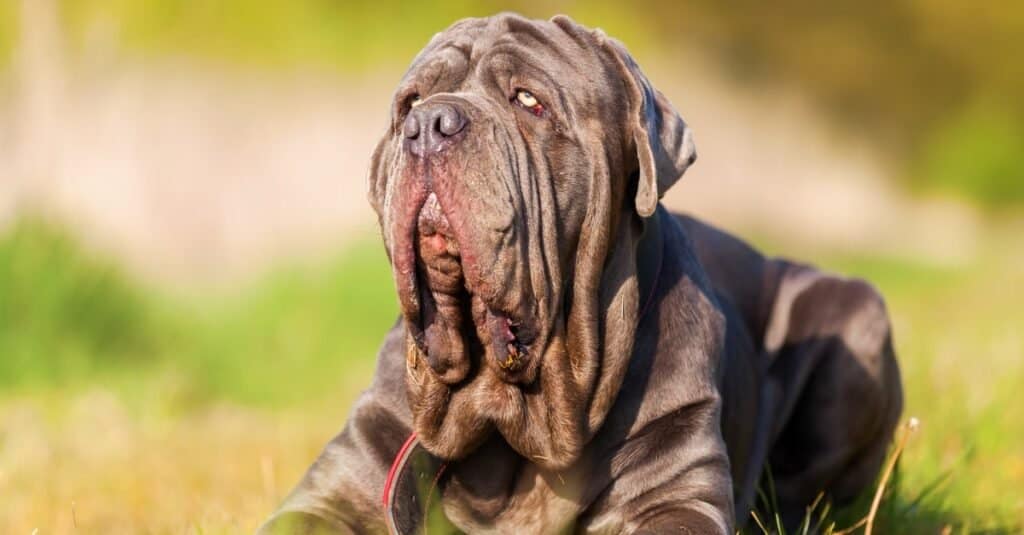
Neapolitan Mastiffs are a magnificent breed of dogs that are extremely loving towards their master and can appear intimidating to strangers.
©iStock.com/chris-mueller
3 Pros and Cons of Owning a Mastiff
| Pros! | Cons! |
|---|---|
| An effective guard dog The loyal nature of this breed is just one of the qualities that make it an excellent guard dog. This dog is wary of strangers and protective of its family. | Lots of drooling These dogs are known to drool a lot which can be messy and inconvenient at times. |
| Affectionate and calm Mastiffs are affectionate with their family members. They maintain a calm attitude even while loud family activities are happening all around them. | Difficult to transport Due to their size, they would be difficult to fit into a small car and it is too heavy to be carried in a crate. |
| Low-maintenance grooming A mastiff has a short-haired coat making it relatively easy to groom at home. | Expensive The initial cost for a purebred mastiff is high. Also, this dog needs a particular type and amount of food making the food bills a little steep for some families. |
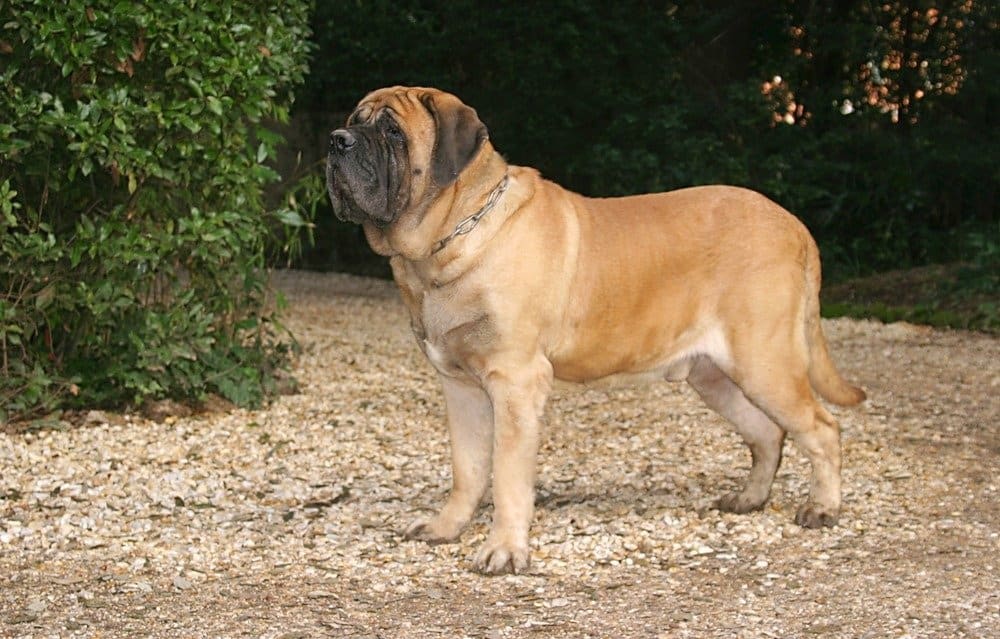
The heaviest mastiff ever weighed 343 pounds!
©Ricantimages/Shutterstock.com
Size and Weight
A mastiff is a large dog with a double coat of short hair. The average height of a male is 31 inches while a female measures 28 inches tall at the shoulder. A male can weigh up to 230 lbs while a fully-grown female weighs up to 170 lbs. At 9 weeks old, a puppy weighs around 30 lbs. They are fully grown at 3 years old.
The record for the heaviest of this breed was an English mastiff that weighed 343 lbs!
| Male | Female | |
|---|---|---|
| Height | 31 inches | 28 inches |
| Weight | 230lbs | 170lbs |
Common Health Issues
One common health issue of these dogs is hip dysplasia. When a dog has this condition, its thigh bone doesn’t fit into the hip joint in the proper way. This can lead to arthritis and mobility issues. Another common health issue is elbow dysplasia. Elbow dysplasia is an inherited condition and occurs when the bones and cartilage in the dog’s elbow joint don’t fit together properly.
Mastiffs are vulnerable to several eye issues. One of them is called progressive retinal atrophy. This condition occurs when the photoreceptor cells in the dog’s eyes start to deteriorate. It can lead to partial or full vision loss.
The most common health issues of these dogs include:
- Hip Dysplasia
- Elbow Dysplasia
- Progressive Retinal Atrophy
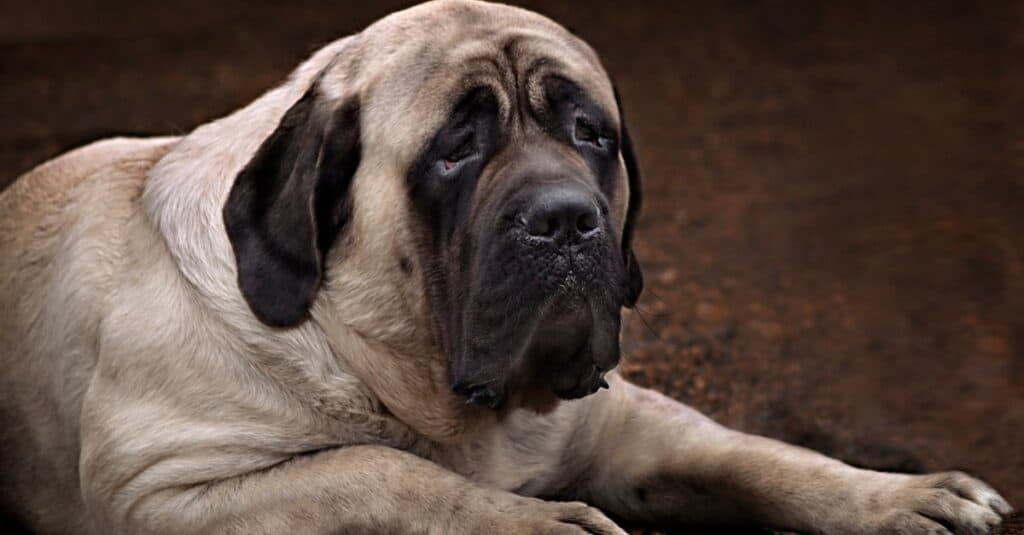
Mastiffs are known to be good family dogs with affectionate, friendly personalities.
©iStock.com/forisana
Temperament and Behavior
These dogs have an affectionate, friendly personalities. This is what makes them good family dogs. They fit in best with families who have older children. At times, this dog’s behavior can be described as that of a couch potato. They’d like nothing more than to sit on the couch next to their owner. However, these dogs need regular exercise such as a walk in the woods, a game of chase in the backyard, or fetching a ball to stay in good health.
One of the most notable traits of this breed is its sensitive nature. They have a talent for reading the facial expressions of their owners. They are people pleasers! This makes obedience training a relatively easy process. But, keep in mind, when an owner speaks with a harsh tone, this dog’s feelings will be hurt. It’s best for an owner to use treats and words of praise with a mastiff during obedience training.
How to Take Care of a Mastiff
As with any breed of dog, this dog needs a certain type of care to maintain good health. For instance, feeding this pet a balanced diet throughout its life can help to prevent the common health issues mentioned above. Furthermore, puppy and adult mastiffs both need the proper amount of exercise each day to stay in shape.
The Best Dog Food for Mastiffs
Not surprisingly, a puppy requires a different diet than an adult dog. Look at the specific ingredients in the feeding routines of puppies and adult dogs. Because of this dog’s immense size, it’s even more crucial to provide adequate nutrition throughout each life stage that’s tailored to the dog’s size and health profile.
Puppy food: The goal of quality puppy food is to promote a slow rate of growth. It’s important for a puppy’s joints, bones, muscles, and tendons to gain strength gradually. This can prevent health problems like hip and elbow dysplasia brought on by a puppy gaining too much weight too quickly. Protein is the main ingredient in quality mastiff puppy food. It builds muscle and contributes to the health of a puppy’s skin and coat. It also provides energy to a puppy without adding needless weight. Calcium is important for the proper growth of bones and teeth. DHA is another ingredient important for brain development and continued eye health. DHA is an ingredient that can work to prevent progressive retinal atrophy.

Mastiffs need plenty of protein and Omega fatty acids in their diets. They won’t be happy if presented with cabbage.
©David Charles Cottam/Shutterstock.com
Adult dog food: Protein is an important ingredient in an adult’s food as well. This nutrient gives the dog energy and continues to build strong bones and muscles in an effort to prevent hip and elbow dysplasia. Omega-3 and Omega-6 fatty acids contribute to an adult dog’s healthy coat and skin. Antioxidants in the food support the dog’s immune system.
The A-Z Animals’ choice of the best dog food for Mastiffs is .
This premium dog food made with beef, fish, and duck provides 30% protein and 20% fat for optimum health and lean muscle. The real meat adds natural glucosamine and chondroitin, essential for cartilage and joints strong enough to support your Mastiff for many years. There’s also taurine to enhance heart and eye health.
VICTOR Realtree Max-5 PRO dog food is available on amazon.
Maintenance and Grooming
How much does a mastiff shed? The English, Neapolitan, and Bullmastiff are all moderate shedders. The Tibetan mastiff sheds very little while its cousin the French mastiff is a heavy shedder. These dogs shed more during the change of seasons. Mastiffs have a double coat of short hair. The daily grooming routine of this breed of dog is relatively easy. A soft brush with boar’s hair bristles is excellent for removing loose or dead hair from this dog’s coat.
A grooming glove is another effective tool especially when it comes to removing loose hair from the dog’s legs and wrinkly face. A grooming glove offers more control while working around the dog’s ears, nose, and eyes. It’s best to brush the dog starting at the head and ending at its tail. This helps an owner brush the hair in its natural direction.
An owner should be on the lookout for skin conditions including patches of dry skin, bald spots, and itchy areas. These can be caused by food or skin allergies or even using a shampoo with ingredients that irritate the dog’s skin.
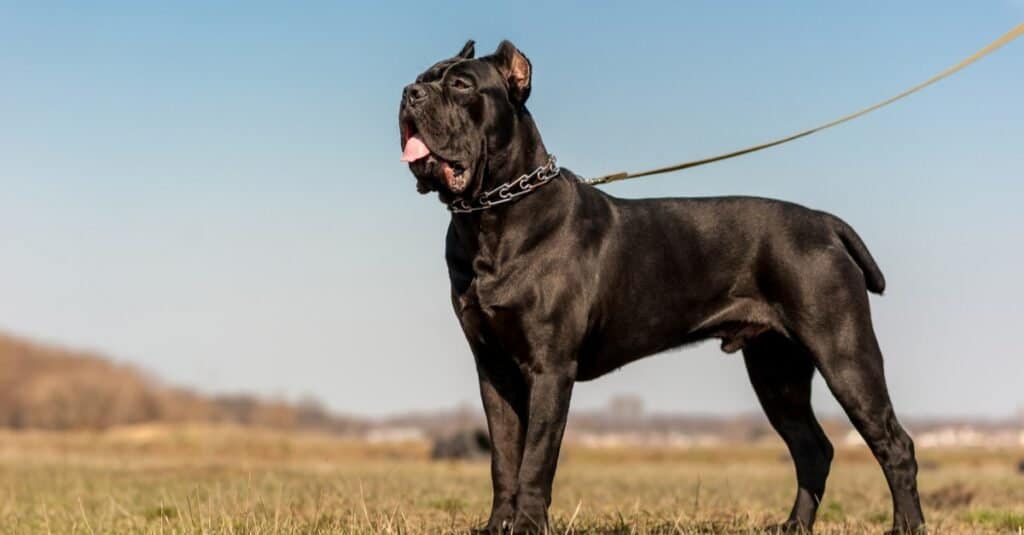
The Italian mastiff doesn’t shed as much or require as much grooming as his Tibetan cousin.
©Dioniya/Shutterstock.com
Mastiff Training
All mastiffs including the Bull, English, French, Italian, Neapolitan, and Tibetan share a sensitive nature. They are relatively easy to train but need an owner to be firm without using harsh words. An owner who uses a harsh tone is not likely to have success in training a mastiff. Words of praise and treats go a long way to effectively conveying obedience lessons to a mastiff. A Great Dane is another large dog with a sensitive nature. It’s relatively easy to train as well when an owner uses words of praise and rewards.
Exercise
Though these dogs are not high-energy dogs, they need daily exercise to control their weight and avoid developing bone, joint, and muscle health issues. Twenty to thirty minutes of exercise per day is a good amount for a mastiff. An ideal exercise routine is a slow walk through the woods or the neighborhood. An owner should avoid jogging with a mastiff because these dogs can become overheated in a short time.
Though these dogs aren’t overly active, it’s not a good choice for apartment life. Its large size would not be suitable for a small living space. This breed needs a backyard where it can stretch its legs and get some fresh air for part of the day.
Puppies
A mastiff puppy should never be overfed. When a mastiff puppy grows and gains weight too quickly, it puts them at risk for developing health issues. Their bones, muscles, and joints need time to develop so they can fully support their large adult body.
These puppies need daily exercise just as adult dogs do. Twenty minutes of walking per day can help a puppy to burn fat.
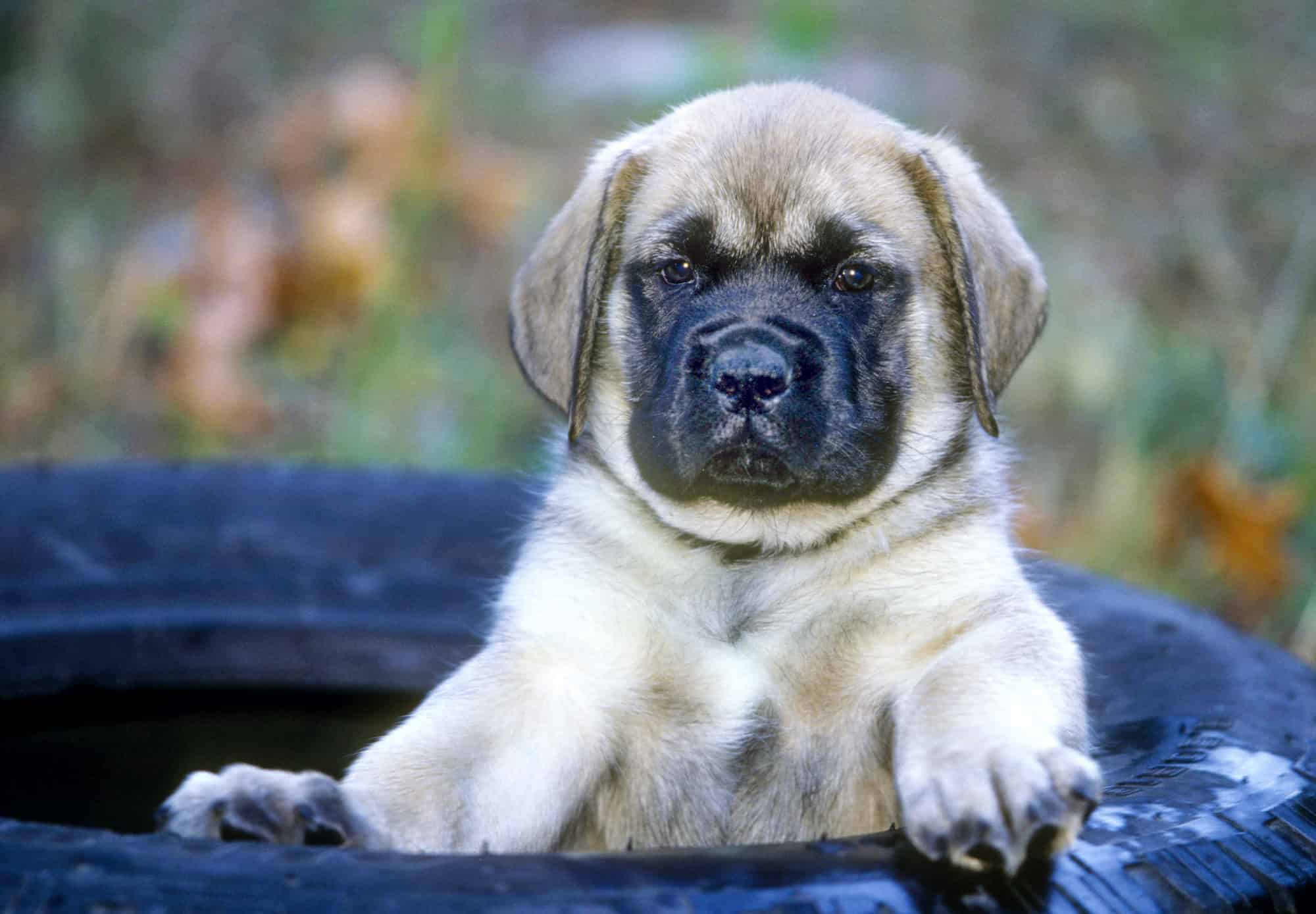
Families with small children should get a mastiff puppy so they can grow up together.
©Jerry Shulman/Shutterstock.com
Children and Mastiffs go Well Together
These dogs are good family dogs and do well with children in a home. These are affectionate, gentle dogs. However, it’s a good idea for a family with small children to get a mastiff puppy. That way, the mastiff has an opportunity to learn how to interact with small children and become accustomed to their behavior.
Dogs Similar to a Mastiff
Some breeds similar to the mastiff include the Great Dane, the Boxer, and the Irish Wolfhound.
- Great Dane – Great Danes and mastiffs are both large dogs. They are both sensitive and friendly. However, Great Danes are a little more energetic than mastiffs.
- Boxer – Boxers and mastiffs do well with children and have a simple grooming routine due to their short-haired coats. Boxers tend to be a little more playful than mastiffs.
- Irish Wolfhound – Irish Wolfhounds are affectionate with a sweet nature like mastiffs. Both these dogs don’t like to be left alone and suffer separation anxiety. An Irish Wolfhound is not as good a guard dog as a mastiff.
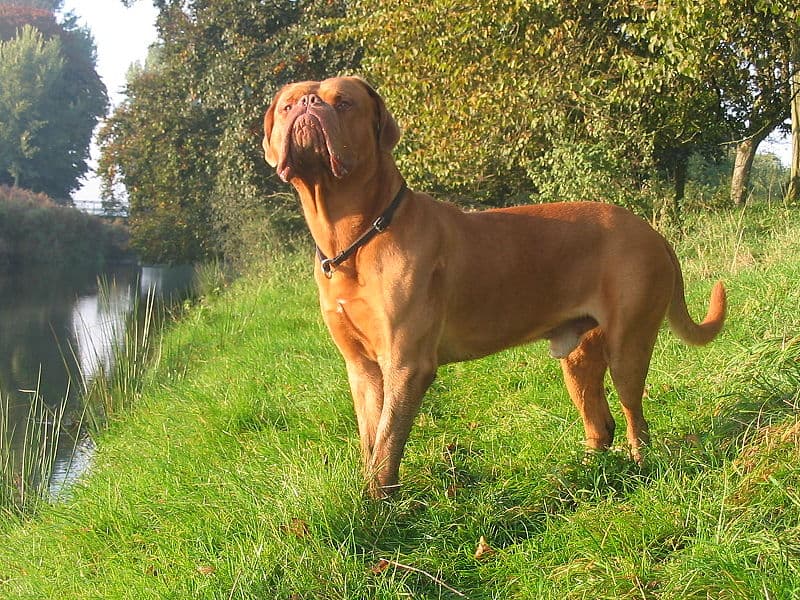
A French mastiff like the one shown above starred in the movie “Turner and Hooch.”
©StBrecht at German Wikipedia / public domain – License
Famous Mastiffs
The mastiff is a popular, memorable dog that’s been seen in a few movies over the years. It’s also a favorite breed of some celebrities.
- Tom Hanks starred alongside a French mastiff in the 1989 movie Turner & Hooch
- Actor Vin Diesel owns a mastiff
- Dwayne Johnson owns a mastiff named The Rock in honor of his wrestling career
Popular Names for Mastiffs
Some popular names for mastiffs include:
- Hercules
- Rocky
- Matilde
- Luna
- Beau
- Juneau
- Koa
Mastiff FAQs (Frequently Asked Questions)
What is a mastiff?
A mastiff is a large, friendly dog and is a member of the working group. There are several breeds including the French, Italian, Neapolitan, Tibetan, and Bullmastiffs.
How much does it cost to own a mastiff?
The initial cost of a mastiff runs from $1800 to $2,500. Tibetan mastiffs are more expensive because they are rarer. The vet costs for a mastiff range between $300 to $500 a year. This varies depending on the general health of the dog.
Food costs can range from $200 to $500 per month depending on what brand an owner chooses.
Is a mastiff a good family dog?
Yes, these are good family dogs that adapt to their environment.
How much does a mastiff weigh?
A male mastiff weighs up to 230lbs and a female weighs 170lbs.
Are mastiffs aggressive?
No, these dogs are affectionate and even-tempered.
Which breed of mastiff is the largest?
The English mastiff is the largest breed.
Is a mastiff good with kids?
Yes, especially if they are brought into a household as a puppy.
How long does a mastiff live?
The lifespan of a mastiff is 6 to 10 years.
Are Mastiffs herbivores, carnivores, or omnivores?
Mastiffs are Omnivores, meaning they eat both plants and other animals.
What Kingdom do Mastiffs belong to?
Mastiffs belong to the Kingdom Animalia.
What class do Mastiffs belong to?
Mastiffs belong to the class Mammalia.
What phylum to Mastiffs belong to?
Mastiffs belong to the phylum Chordata.
What family do Mastiffs belong to?
Mastiffs belong to the family Canidae.
What order do Mastiffs belong to?
Mastiffs belong to the order Carnivora.
What genus do Mastiffs belong to?
Mastiffs belong to the genus Canis.
What type of covering do Mastiffs have?
Mastiffs are covered in Hair.
What is an interesting fact about Mastiffs?
Mastiffs are courageous, calm, and affectionate!
What is the scientific name for the Mastiff?
The scientific name for the Mastiff is Canis lupus.
How does a Tibetan Mastiff compare to a wolf?
Wolves are more powerful predators than Tibetan Mastiffs, though they are roughly the same size and weight. Read all about their differences here!
What are the differences between a Bullmastiff and an English Mastiff?
The most evident difference between the two breeds is their size, with the English Mastiff being far larger than the Bullmastiff.
You can read about all the other differences here.
What are the differences between a Great Dane and a Mastiff?
The major differences between the Great Dane and the English Mastiff are their size, temperament, health condition, and appearance. Their position on the gigantic spectrum is another reason to mention. For example, the Great Dane is a very tall and long dog, but the English Mastiff is very broad.
What are the differences between Mastiffs and Cane Corsos?
The key differences between the Mastiff and the Cane Corso are in terms of personality, temperament, and of course, size.
The Cane Corso and the Mastiff have unique personalities and temperaments. While these two dogs may look similar, they have dissimilar training needs. Prospective owners of either breed will need to provide specialized obedience training suited to their dog, especially in the case of the inexperienced owner.
What is the key difference between Mastiff and St Bernard?
The key difference between a Mastiff and a St. Bernard is size. Mastiffs can weigh up to 50 pounds more than St. Bernards. Other differences include appearance, lifespan, grooming needs, and drooling level.
Thank you for reading! Have some feedback for us? Contact the AZ Animals editorial team.
Sources
- David Burnie, Dorling Kindersley (2011) Animal, The Definitive Visual Guide To The World's Wildlife
- Tom Jackson, Lorenz Books (2007) The World Encyclopedia Of Animals
- David Burnie, Kingfisher (2011) The Kingfisher Animal Encyclopedia
- David Burnie, Dorling Kindersley (2008) Illustrated Encyclopedia Of Animals
- Dorling Kindersley (2006) Dorling Kindersley Encyclopedia Of Animals
- American Kennel Club, Available here: https://www.akc.org/dog-breeds/mastiff/

